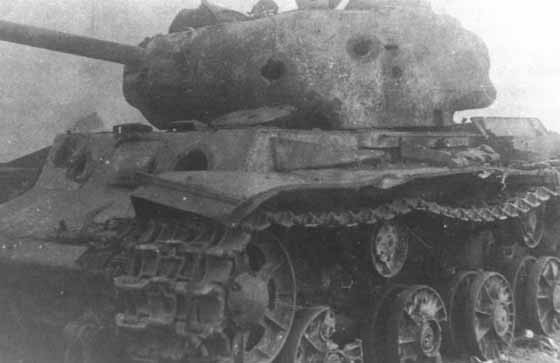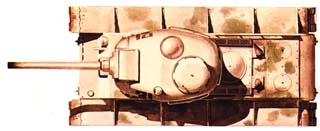KV-1S AND KV-85 heavy tanks
|
| Weigth |
46 tons |
| Crew |
4 |
| Weapons |
85mm L51,5 M43 gun with 71 rounds, 2 DT-type
MG with 3267 rounds |
| Armor |
hull 30-70mm (nose 70mm, sloped plate 60mm,
front 70mm, sides and rear 60mm, top and bottom
30mm); turret 35-110mm (front 110mm, sides and
rear 100mm, top 30mm) |
| Engine |
600hp diesel V2 K, 12-cylinders on V, liquid
cooled |
| Speed |
42Km/h |
| Autonomy |
330Km |
| Length (max) |
8,60m |
| Width |
3,25m |
| Height |
2,80m |
|
Advantages: armor protection, mobility (autonomy, diesel
engine, speed, large tracks), powerful gun (the 85mm gun was
adequate against the new Tigers and Panthers, also being a little
inferior as piercing capabilities and less precise due to poor
optic devices)
Disadvantages: armor was thin, making the tank unable to
counter the new German heavy panzers
Troubles for the heavies...
General Rotmistrov said at proposal of the situation of the
Soviet armored formations in 1942: "The difficulty is
that while there is not much difference between the light [T-60]
and medium [T-34] tanks on the roads, when moving cross-country
the light tanks are quickly left behind. The heavy tank [KV] is
already behind and often crushed local bridges which cut off
units following after. Under battlefield conditions, that too
often meant that the T34 alone arrived.; the light tanks had
difficulty fighting the German tanks and the KVs were still
delayed in the rear. It was also difficult to command these
companies as they sometimes were equipped with different types of
radios or none at all". Rotmistrov concluded that it
would be more prudent concentrate industrial resources upon a
single 'universal tank', instead of wasting them between
different light, medium and heavy types.
In the 1942 the KV-1C had troubles in operating in the Soviet
mixed battalions and brigades were the fast T-34/76 was
predominant: the KV went under a radical re-design. Many Russian
tankers where queried about the needed improvements. It was
decided to reduce the armor thickness in the hull (75mm on front,
60mm on the sides) and in the turret (max 85mm), making massive
use of welded parts and a better ballistically shaped turret.
 |
KV-1 model 1942 armor scheme
(Photo by Valera Potapov)
|
The result was the KV-1s tank (for "skorostny",
fast) which, getting a weight of 41,8 tons, could reach a maximum
speed of 39 km/h. New KV-1s were producted from August 1942 to
April 1943 immediately reducing the gap with the T-34 (also
because this tank was becoming heavier). Unfortunately Soviets
reduced armor on their heavy tank just while the Germans were
unleashing on the battlefields the Tigers and Panthers with their
hard-hitting cannons and heavy armor.
One of the most important improvements took place in the
turret with the addition of a cupola (sadly lacking the hatch!)
for the commander, which was finally relieved of reloading the
gun. The redundant machinegunner took his place. The prototype
could carry 90 rounds but the serial vehicles take this up to
114. Both standard T-34's F-34 and KV-1's ZIS-5 76,2mm tank guns
could be mounted because Chelyabinsk factory was producing both
type of armored vehicles. As well a flamethrower variant of the
new model of KV was equally developed and took name of KV-8s: it
was armed with a 45mm gun (92 rounds) and a flamethrower device
with a fuel capacity tank of 960 litres.
In Summer 1942 trials on the new vehicle ended and the
production begun on August 20th 1942. In the meanwhile the war
experience took other bad news for the heavy tanks in the Red
Army as they were proving unsuccesfull. Gen. Katukov said: "The
T-34 fulfillsall our hopes and has proven itself in combat. But
the KV heavy tank ... the soldiers don't like it ... It is very
heavy and clumsy and not very agile. It surmounts obstacles with
great difficulty. It often damages bridges and becomes involved
in other accidents. More to the point, it is equipped with the
same 76 mm gun as the T-34. This raises a question, to what
extent is it superior to the T-34? If the KV had a more potent
gun or one of greater calibre, then it might be possible to
excuse its shortcomings".
 |
New KV-1s being delivered to the
Red Army
|
Effectively the KV has spent its best time of 1941 and early
1942, when Soviet tankers requested him as king of the
battlefield. As a temporary measure the KV heavy tanks were
removed from the mixed brigades and concentrated in separate
heavy tank regiments for use in infantry support role. The
situation led to a radically new project for a 'universal' tank
retaining the armor protection of an heavy tank and the weight of
a medium one.
The design team of the KV proposed the KV-13 while the T-34's
design team proposed the T-43. KV-13 weighted about 31 tons, had
120mm front hull and 90mm turret armor; gun was the usual 76,2 mm
L41. As for the KV-1s the appearance of the heavy German Tigers
and Panthers made clear that the ideas were going in the wrong
direction.
 |
KV-1s had too thin armor and gun
to counter the new German panzers
|
Accent was put once again on the armor protection and
firepower because the standard 76,2mm L41,2 gun was only useful
at very short (read suicidal) ranges against the Tiger and
unuseful against the new Panther's frontal plate. At Kursk this
proved irremediably dramatic.
When the new IS-I tank was delayed because of industrial
priorities for the T-34 medium tank there were plans for updating
the KV design with a bigger gun. A project which contemplated the
installation of the 85 mm gun in an un-modified KV-1s turret was
stopped because the internal room could not permit the crew to
operate. A new turret design was needed.
The turret of the IS tanks which was beginning to be
manufactured was then installed on the KV hull; the larger
diameter race was accomodated by adding a pair of fillets along
the hull sides. This was hardly ideal but the tank was only a
temporary measure. This turret was armed with the 85mm L51,5 D-5T
anti-tank gun and used cast and melted plates being heavily
protected (110-100mm).
 |
KV-85, 1943
|
Along with some standard KV-1c which were also retrofitted
with the new turret, new KV-85s were first employed in the Winter
1943 offensive in Ukraine as breaktrough tank, performing well.
Because they were a stop-gap design and because Soviets had
finally speeded up the Iosif Stalin heavy tank project,
production ceased with only 130 KV-85s built or modified.
New heavy assault guns ...
Red Army was still missing a heavy assault gun which could
support infantry attacks with heavy fire. Encouraged by SU-122's
good proofs and, moreover, by succesful German Sturmgeschutz,
K.A. Kotin started designed a new vehicle matching the requests:
it was then decided to use the KV-1s chassis equipped with a
fixed 75mmm armor thickness super-structure and a 152mm L32 ML-20
howitzer for this role: after only 25 days first SU-152 was out
of factory.
Production started on March 1st 1943 and gradually replaced
the production of the KV-1s. By September of the same year, when
manufacture ended, 704 had been built. They went to equip the SU
heavy assault artillery regiments (12 SUs for regiment, later 21)
and first ones reached the front units at the times of the German
Summer offensive at Kursk. Thirty-five of these vehicles were
completed as SU-122 (to not be confused with T-34 derived assault
gun), armed with the high velocity 122mm L43 A 19S gun.
 |
SU-152 armor scheme (Photo by
Valera Potapov)
|
During the Kursk battle this assault gun was highly
appreciated by the Soviet tankers: its gun had a remarkable
anti-tank capability, being able, with its 45Kg AP rounds fired
at 650 m/s to pierce a 120mm thick plate at 1,000 metres and so
to take out the new heavy German Panthers, Tigers and Ferdinands.
The HE shell were also decisive being able to procure not field
reparable damage to tanks and/or immobilize them.
The regiment urgently rushed in the Orel salient was credited
of the destruction of 12 Tigers and seven Elefants in three weeks
of fighting. After these results it was granted of the
"Animal killer" nickname. The SU-152 heavy assault gun
concept was so much succesfull that the Soviets adapted it on the
next generation heavy tank, the IS- II.
 |
SU-152 heavy assault gun (1943)
|

|
This page is online thanks to Geocities, the
largest Web Community! Get your own
free page at Geocities!!!
|








